| [naar
inhoudsoverzicht muziekgeschiedenis]
[naar
inhoudsoverzicht korte biografieen]
[naar Schoenberg-
biografie
1]
[terug naar inhoud
Schoenberg-biografie 2]
[naar
literatuurlijst]
inhoud:
inhoud:
Vienna at the turn of
the century
Further
reading
|
1874-1913
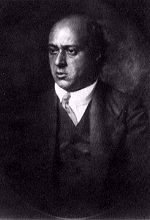
Arnold Schönberg
1874 - Childhood in Vienna
Arnold Schönberg was born in Vienna on September 13th 1874
as son of the merchant Samuel Schönberg (deceased in 1890) and his
wife Pauline (deceased in 1921). With 8 years he learnt as autodidact the
violin playing and began to compose. After having been an apprentice with
a bank clerk, he joined the orchestra „Polyhymnia" in 1891. Since that
time, he kept up a lifelong friendship with Alexander von Zemlinsky (1871-1942),
the conductor of the orchestra. He was himself conductor of the metalworker-choir
in Stockerau.
1897 - First compositions
In 1897, he composed the string quartet D major, follwed by numerous lieder
compositions (op 1, 2 and 3) during the next two years. With the string
sextet „Verklärte Nacht" op 4 (composed in 1899, revised for string
orchestra in 1917 and 1943) Schönberg overstepped for the first time
the line of tonality.
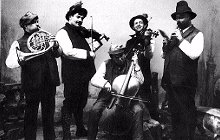
The autodidact Schönberg
playing an amusing quintet
1901 - Years of apprenticeship in Berlin
In 1901, Schönberg married Mathilde, Alexander von Zemlinsky's sister,
and took the job as conductor with Ernst von Wilzogen's „Überbrettl"
in Berlin. For Wolzogen's stage he composed the „Brettl-Lieder" after satirical
texts by contemporary poets.
Berlin was very important for Schönberg's further artistic
development. In 1902, he received on Richard Strauss' recommendation the
popular Liszt-scholarship as well as a, apprenticeship at the Stern conservatory.
Before returning to Vienna in 1903, he composed the symphonic poem „Pelleas
und Melisande" op 5, where the limits of tonality were appreciably extended.
1904 - Verein schaffender Tonkünstler (society of creative musicians)
In Vienna, Schönberg began to teach at the Schwarzwaldschule,
a place of educational spadework in Vienna at the turn of the century.
His brother-in-law Alexander von Zemlinsky introduced him to the then court
opera director Gustav Mahler, who gave his support to Schönberg.

Eugenie Schwarzwald,
the famous Viennese
reforming educationalist
Schönberg founded himself the „Verein schaffender Tonkünstler"
(society of creative musicians) in 1904 and made so the first step
towards a diffusion of his compositions. The society made it his duty to
present contemporary music in concerts. This year, Anton von Webern and
Alban Berg became Schönberg's students.
1906 - Atonality
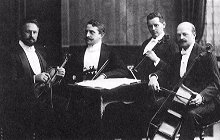
The year 1906 may be considered as one of the numerous births of modern
music. Schönberg's music caused a cultural shock. The legendary „scandal
concert" of 1908, where the 1st and 2nd string quartet op 10 and the chamber
symphony op 9 were performed for the first time, was received with a lack
of understanding by the press and with vociferous protests by the public.
It points to Schönberg's artistic personality that such incidents
could not divert him from his conception of modernity. He professed at
that time: „The taste of the public does never affect the real artist,
because he is not able to create something else but to what he is pressed
by his nature and development. Unfortunately some people believe now and
then that he can act according to the public and the momentary success
does even pay, but the betrayal takes it's toll later by all means. Because
someone who does not carry in a way the nature of the public inside himself
will not hit it to be liked entirely. The fake is soon discovered and the
betrayal is futile in most cases."
1909 - The expressionist phase
Without hope of predictable public acceptance, he composed in the next
years the opera „Die glückliche Hand" op 18 (finished in 1913),
„Drei
Klavierstücke" op 11, „Fünfzehn Gedichte aus 'Das Buch
der hängenden Gärten'" op 15 and „Fünf Orchesterstücke"
op 16 as well as the monodrama „Erwartung" op 17 (text: Marie Pappenheim).
In these compositions Schönberg devoted himself to the expressionism
to which he adhered also in his numerous paintings of these years.
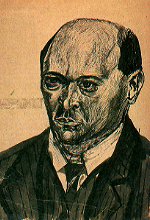
Self-portrait 1908
The thematic commitments of the music were also dissolved with the tonal
references. The musical happenings are no longer pledged to a tangible
and restricted theme. The short expressive motif moves in the center of
the composition as a basic unit of the compositional development.
1911 - Financial difficulties
In 1910, neither the first exhibition of paintings at a library in Vienna
nor the application for a professorship at the conservatory of Vienna were
successful. The utterly critical financial situation of the Schönberg
family was scarcely improved by his work as private lecturer. Personalities
such as the composer Ferruccio Busoni and the writer Alfred Kerr spoke
up for him in a collection campaign in the Berlin art magazine „Pan".
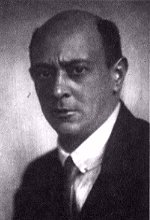
Schönberg 1909
1913 - First successes
After having finished the „Harmony", the most fundamental theoretic exposé
of the subject till today, and the oratorio „Gurrelieder", Schönberg
returned with his wife and his two children to Berlin, where he received
a lectureship at the Stern conservatory. „Sechs kleine Klavierstücke"
op 19 and the setting to music of Maeterlinck's „Herzgewächse" op
20, both composed in Berlin, prepare the aesthetic ground for the cycle
„Pierrot lunaire" op 21 (begun in 1912, text by Albert Giraud, translation
by Hartleben). In this cycle Schönberg develops an own technique of
the recitative, the so-called „pitch speaking". The pitches of the voice
were no longer exactly determined, the melodic and rhythmic development
is adapted to the speech ductus.
On the occasion of the course of performances of „Pierrot" in
Berlin (with the diseuse Albertine Zehme), Schönberg met Igor Strawinsky
and Giacomo Puccini as well, who had words of appreciation for the work.
In 1913, the première of the „Gurrelieder" in Vienna
found great recognition by the press and the public. The late Romantic
work, in which all components of Schönberg's aesthetics - although
in a very moderated form - are already present, met with the same great
interest as the Schönberg's concerts in England and in the Netherlands
in 1914.
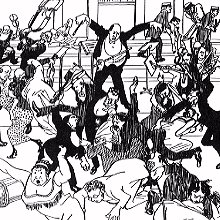
„The next Schönberg
concert in Vienna"
Cartoon of 1913
|